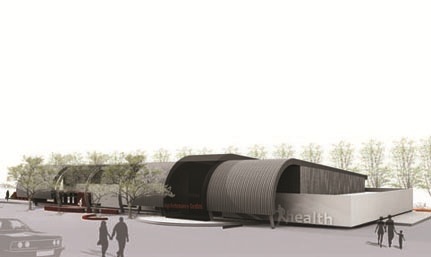|

|
| Graphical representation of the High Performance Centre |
“Come gather round people, wherever you roam. And admit that the waters around you have grown…”
These are the opening lines of Bob Dylan’s iconic single The times they are-a changing. They are also extremely apt words to describe the excitement about the winds of change and growth blowing across the University of the Free State, not only academically, but also physically.
Over the past few months there has been non-stop construction and growth of a physical nature, with several new buildings being erected and new sculptures rising up all over the Bloemfontein Campus.
The most visible and probably the most striking of all the new structures is the brand-new main entrance to the campus. This stunning new feature welcomes visitors to the campus in Nelson Mandela Drive, in the colours of each of the university’s seven faculties.
Once through this beautiful new gate, visitors have a choice of new and exciting features to explore on the campus.
The first is the brand new climbing wall, which is located against the West Block and Chemistry Buildings. This new addition to the campus is available for use by all enthusiasts of this exciting sport.
The Office of the Dean of Student Affairs manages the administration of the wall and students who want to climb can book at their office in the Student Centre at the Thakaneng Bridge. In order to ensure that students do not use the wall without permission, and to prevent accidents, the wall is covered by a tarpaulin, which is locked when the wall is not in use.
Next on the list of new developments is the high-performance gymnasium which is currently still under construction. With this project the university wants to create a work environment for its staff that will not only contribute to the cultivation of maximum work performance, but also to staff wellness.
The centre with its foyer and administrative offices will also consist of a health desk, university sports institute, sports sales, a spinning and aerobic centre, and dressing rooms. The total area will extend more than 2114 m².
Progress on other building projects, which commenced last year, is also very pleasing. One of the projects is a new Education Building which is being constructed opposite the UFS Sasol Library. Upon completion, this building will be used for the training of maths and science teachers in the Foundation Phase. It will include three classrooms for 100 students each and an auditorium for 225 students as well as an office block. The auditorium will also be used as a classroom. The building has been designed according to environmentally friendly principles to save water and use power effectively. Construction is going swimmingly and should be completed soon.
Planning for the construction of more student accommodation on the Bloemfontein Campus as well as the Qwaqwa Campus is also well underway. On the Qwaqwa Campus, a residence with 200 beds is being constructed. This also includes a computer laboratory. According to the planning, this residence is near completion. Furthermore, four residences will be constructed on the Bloemfontein Campus. These residences are in the planning phase.
In order to place technology within reach of Kovsie students and thereby empowering them, computer laboratories were installed at all residences. The computer laboratories will eventually make provision for approximately185 computers for student use. Proper security is also planned to safeguard the equipment.
A brand-new building for the Faculty of Health Sciences is also proceeding rapidly. This building will include a lecture hall for 200 students, five venues for 100 students each, as well as offices. Students from the School for Medicine and Occupational Therapy will make use of these facilities.
The new building for the Faculty of Economic and Management Sciences between the Flippie Groenewoud Building and the Wynand Mouton Theatre is also coming along nicely.
On the university’s Qwaqwa Campus a new Education building is being constructed. This building will include a lecturing hall with 100 seats, four 50-seat classrooms, six offices, ablution facilities, biology and science laboratory, as well as an information technology laboratory for 60 students.
In the meantime, existing buildings are being renovated on all the campuses. This includes, amongst others, improvements to the Architecture Building, the Biotechnology Building and the quarters for service workers on the Bloemfontein Campus. Other improvements that have already been completed include renovations to the Odeion’s foyer and the Callie Human Centre.
A special memorial park for women, residential accommodation within a sports environment, and a botanical garden are also among the beautiful, exciting new sites to be seen on the campus.
Coupled with all the beautiful sculptures, funded by the Lotto Sculpture project, our university’s campuses will soon be a more vibrant, beautiful attraction.